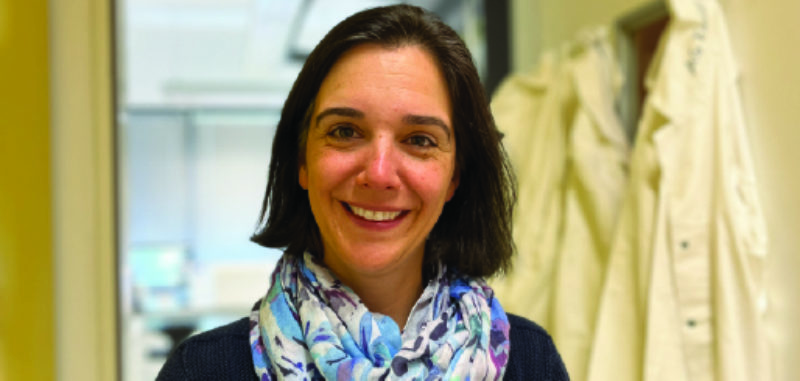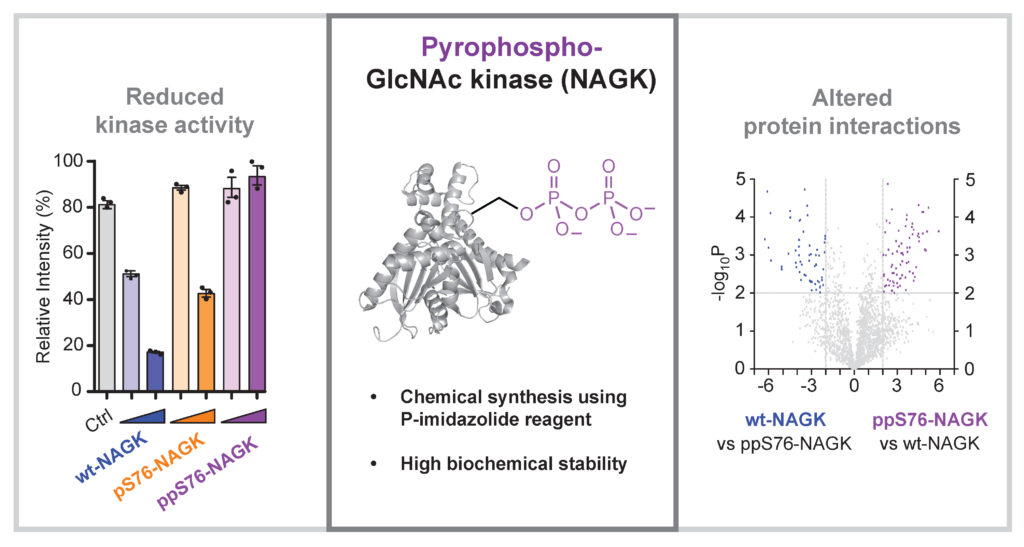
Stories

Dorothea Fiedler: Captivated by Chemistry
Dorothea Fiedler grew up in Germany and had the opportunity to attend a British boarding school as an exchange student for one year. It was around this time that she found herself enchanted by chemistry. “Our chemistry classroom was a little bit like potions class, like in the Harry Potter movies, and I think I just really liked it. It had this gravitas. It was fun,” she recalls.
Fiedler always enjoyed learning about science but found chemistry particularly captivating. “Chemistry gave me structure and clarity,” she explains. With the support of inspiring chemistry teachers who doubled as her field hockey coaches, cheering her on in the lab as well as on the field, Fiedler planned and conducted her first experiments. “We spent a lot of time talking about chemistry, and for the first time, setting up experiments. [In one experiment] we synthesized aspirin. That’s when I really started loving chemistry. [The fact that] the whole world is made out of molecules of different compositions that affect our day-to-day life is a concept that really captivated me,” says Fiedler.
After high school, Fiedler attended Julius-Maximilians Universität Würzburg, then went on to earn her Ph.D. at the University of California, Berkeley. It was there that she explored inorganic chemistry and host-guest chemistry, which explores the structural relationships in complexes composed of two or more molecules or ions. Several of her colleagues investigated the role of metals in the environment and how bacteria sequester metals. It was a fascinating research direction, but she soon realized their lab wasn’t equipped to dive into the biological questions. Instead, at a certain point in the work, projects were shipped off for further investigation by collaborators.
“I just realized that everything boils back down to chemistry—chemical reactions form the basis for everything that’s happening in cells,” Fiedler explains. “That’s when I knew I wanted to just learn more about it, in general.” Determined to bridge the gap between chemistry and biology, Fiedler completed her postdoctoral fellowship at University of California, San Francisco, with Kevin Shokat studying signal transduction pathways—the process by which cells transmit chemical or physical signals.
“Even though the transition was a bit hard, I really appreciated that I had the opportunity to switch fields and then do a postdoc,” she says. Equipped with this unique background in inorganic chemistry combined with molecular biology, Fiedler was ready to start her own lab at Princeton University, focusing on protein signaling and metabolic networks.
In 2013, Fiedler was selected as a Rita Allen Foundation Scholar, marking a significant turning point in her career. “It gave me confidence to pursue an idea that felt risky at the time—exploring phosphate homeostasis in diseases like cancer, and I couldn’t wait to throw myself into it,” she says. Shortly after, however, an unexpected opportunity presented itself and Fiedler found herself faced with a career-defining decision.
“After around three years at Princeton, the Leibniz-Forschungsinstitut für Molekulare Pharmakologie (Leibniz Institute for Molecular Pharmacology) in Berlin contacted me,” Fiedler recalls. They had a position opening for a joint appointment with the Humboldt University in Berlin for a full professorship, and much to her surprise they invited her to apply. “It felt like I had just started [at Princeton]!”
“There’s probably never the perfect time to move from one continent to another,” Fiedler reflects. When she relocated from Princeton, New Jersey, to Berlin, Germany, she knew she was taking on an immense challenge—one that extended beyond science.
Moving a lab isn’t just about packing up equipment and setting up in a new location. “The lab started small, and I had to sort of start up again,” she explains. While she was fortunate that three of her graduate students moved with her, along with a fourth, eager to join her team in Germany, rebuilding from the ground up meant navigating logistical, administrative, and cultural differences in a new research environment.
“We were not down to zero, but getting everything set up again was a challenge; not a scientific challenge, but an organizational one,” she says. Beyond securing funding and resources, she had to establish new collaborations and integrate into the German scientific community—all while ensuring continuity in her research.
Throughout the transition, the Rita Allen Foundation played a crucial role in supporting her work. “The Rita Allen Foundation was really helpful and accommodating to the move. Talking to the Foundation [about moving my lab] was very un-bureaucratic and easy. I was very grateful for that.” More than just practical flexibility, the award reassured her that her research direction was meaningful and valuable. “It reassured me that this idea to look at phosphate homeostasis, and its influence on cellular signaling pathways, was not a crazy idea, and we’re still doing it.”
Fiedler is now Managing Director of the Leibniz-Forschungsinstitut für Molekulare Pharmakologie, where she leads research on how cells use different biochemical mechanisms to transmit information. “We do basic science, and we’re generally interested in cellular signaling—there are many different processes that have to take place so that our cells are able to communicate with each other and that they can process information internally,” she explains. Cells must constantly survey their surroundings—determining if there are adequate nutrients to grow, whether they should respond to stress signals—and then they have to adjust their behavior accordingly. “This communication is often dependent on certain messenger molecules or small chemical modifications which are essentially the languages that the different components in your cells speak.”
For Fiedler, this “chemical language” is at the heart of her work. “It turns out there are many different languages. And just like for humans, when cells don’t communicate properly, it leads to problems,” she says. Her lab aims to decode these biochemical messages, understand how miscommunication leads to disease, and explore ways to correct these errors.
One major focus of her lab is phosphate-based signaling, particularly how phosphate modifications regulate proteins in cellular signaling cascades. These cascades are a series of chemical modifications, where one protein modification triggers the next, ultimately leading to the activation or deactivation of specific processes.
Recently, her team made an interesting discovery about pyrophosphorylation—a process where proteins can be modified with more than one phosphate group at the same site. While phosphorylation occurs abundantly on proteins throughout the cell, the concept of having pyrophosphorylated sites is intriguing, because this modification seems to be able to integrate two separate inputs.
The existence of this “new language” was first proposed about 20 years ago, but Fiedler’s lab was able to confirm that this happens in intact cells. “Back then, my colleagues used really hardcore biochemical experiments with radiolabeling, and working in a test tube with purified proteins,” she says. One common critique of this approach was that results in test tubes don’t always reflect what happens inside cells. “I always said we need to observe this modification by mass spectrometry because then we can see exactly where it happens on a protein. But the big challenge is to distinguish between having two phosphates next to each other, or attached to each other. This was tricky, but we managed to do it!” Interestingly, their findings point toward a role for protein pyrophosphorylation as a means of regulating the production of ribosomes, which is one of the most energy-consuming processes in our cells.
One of Fiedler’s recent studies uncovered yet another phosphorylation-based language, called protein oligophosphorylation. Her group discovered that the addition of a second phosphate (as in protein pyrophosphorylation) is not the full story, and that phosphate chains—up to six of them—can be attached to a single site on a protein. This discovery now calls for new chemical and analytical tools, so that her group can begin to investigate how this unexpected modification can change protein structure and function.
Beyond her discoveries, Fiedler finds deep satisfaction in mentorship and collaboration. “I’m really proud of the people that have come through the lab. We’ve worked on some difficult projects, and they were determined to try new things and then stick with it. I’m very grateful that I’ve had wonderful coworkers.”

Here, Fiedler describes challenges she encounters in research, rapidly advancing technology in science, and what she enjoys doing outside of the lab.
What are the biggest challenges in your research?
Since we are a group doing basic research, I sometimes find it difficult to formulate (and communicate) the best and potentially most impactful questions. If we set up an experiment based on a certain hypothesis and we get exactly the result we expected, that is good, but also a little bit boring. If we set up a really open-ended experiment, it is easy to get overwhelmed by all the potential implications. So, striking the right balance here is what we call Drahtseilakt in German.
We live in a time when technology is rapidly advancing. Can you speak to how that affects emerging science, and more specifically, how that might change your science and/or your approach to science?
In my field we very much appreciate the technological advances. Since we are not technology developers ourselves, we do not compete to reach certain milestones on that front. Instead, we benefit from all the different advances, whether these are the continuous improvements for highly sensitive mass spectrometers, structural biology insights enabled by cryo EM [cryogenic electron microscopy—a method to image frozen biological molecules], or new gene editing techniques. That being said, science is becoming more and more fast-paced, and it sometimes feels hard to keep up with all the developments.
What do you like to do when you are not in the lab?
I like to spend time with my family. Whether this is an evening of board games, hiking together or skiing together, I value those moments very much. I also enjoy exploring the area around Berlin by bike. And my husband and I very much appreciate the amazing restaurant scene in Berlin.